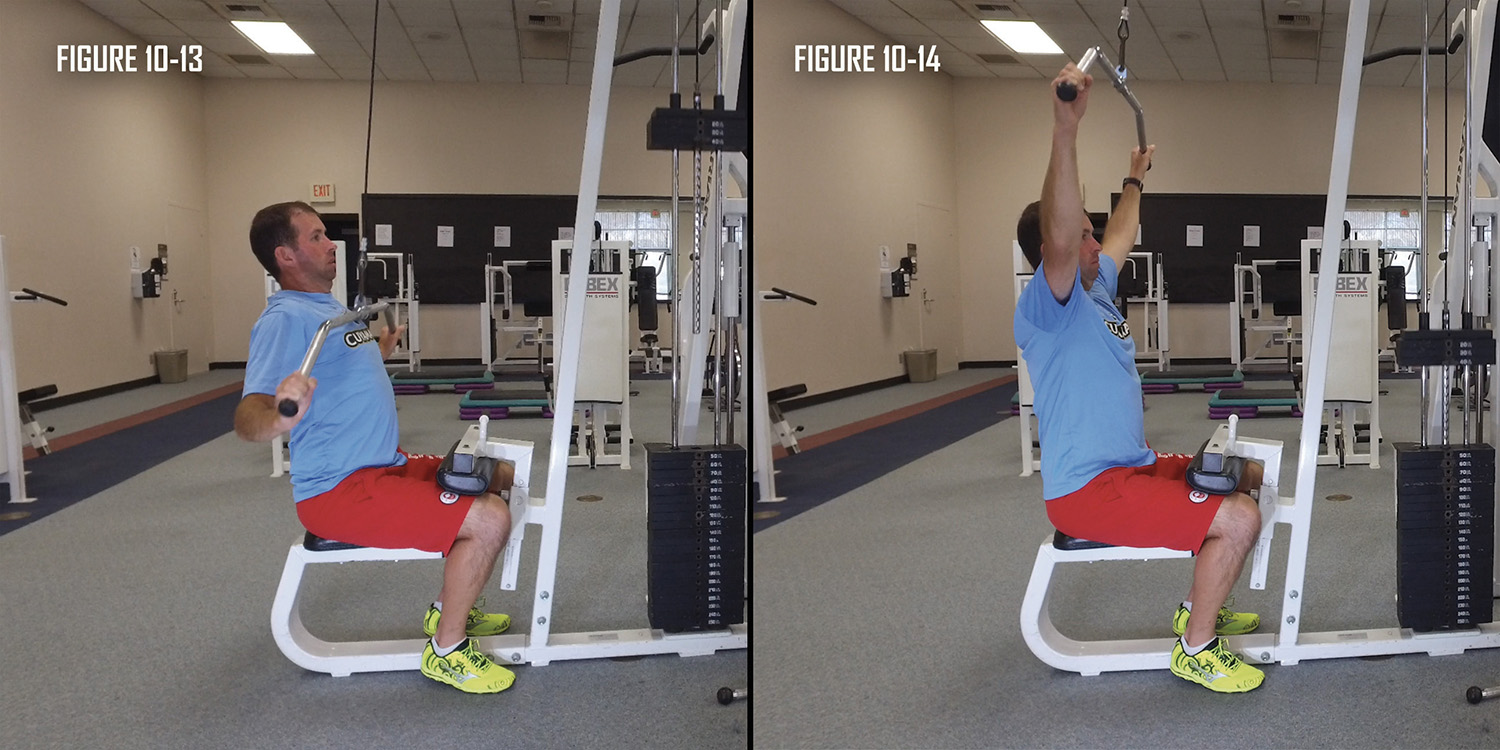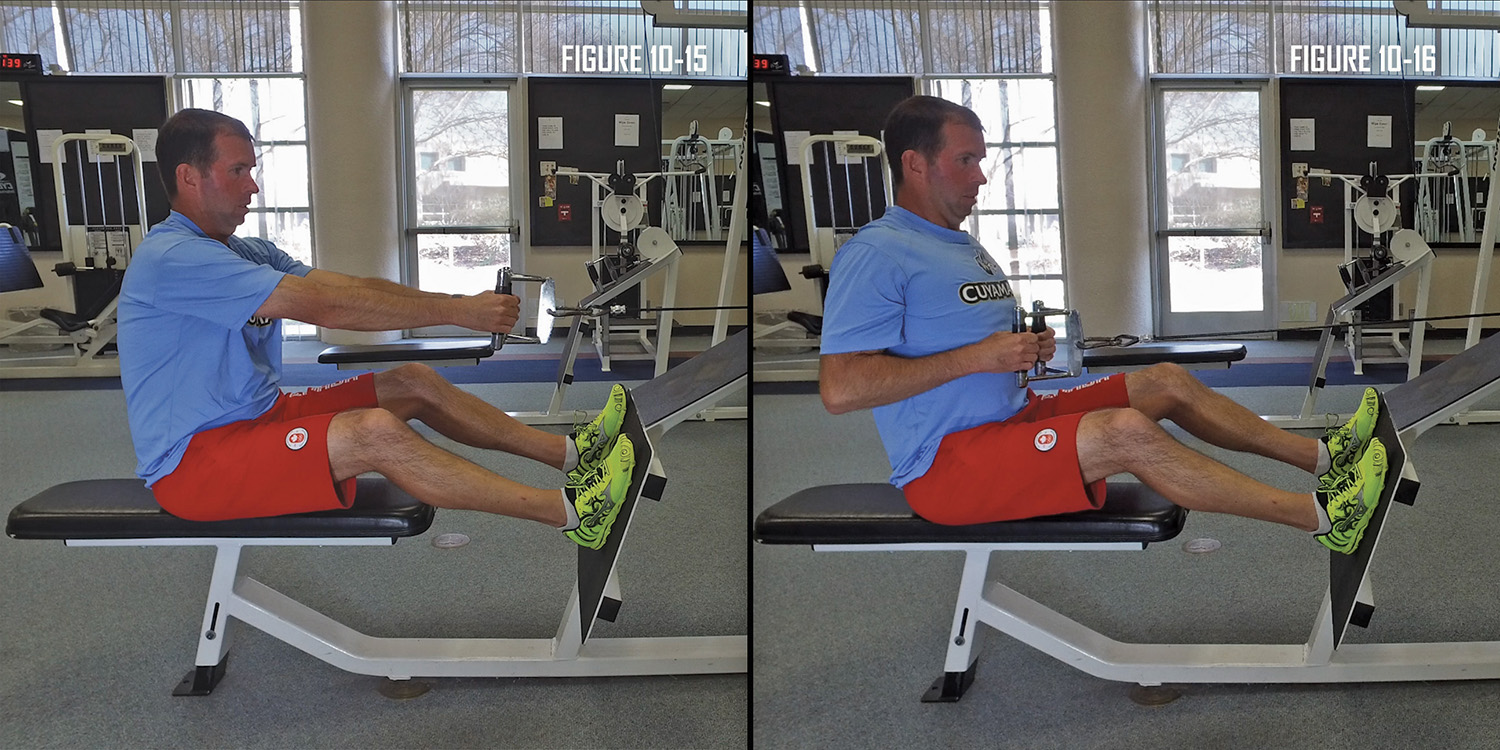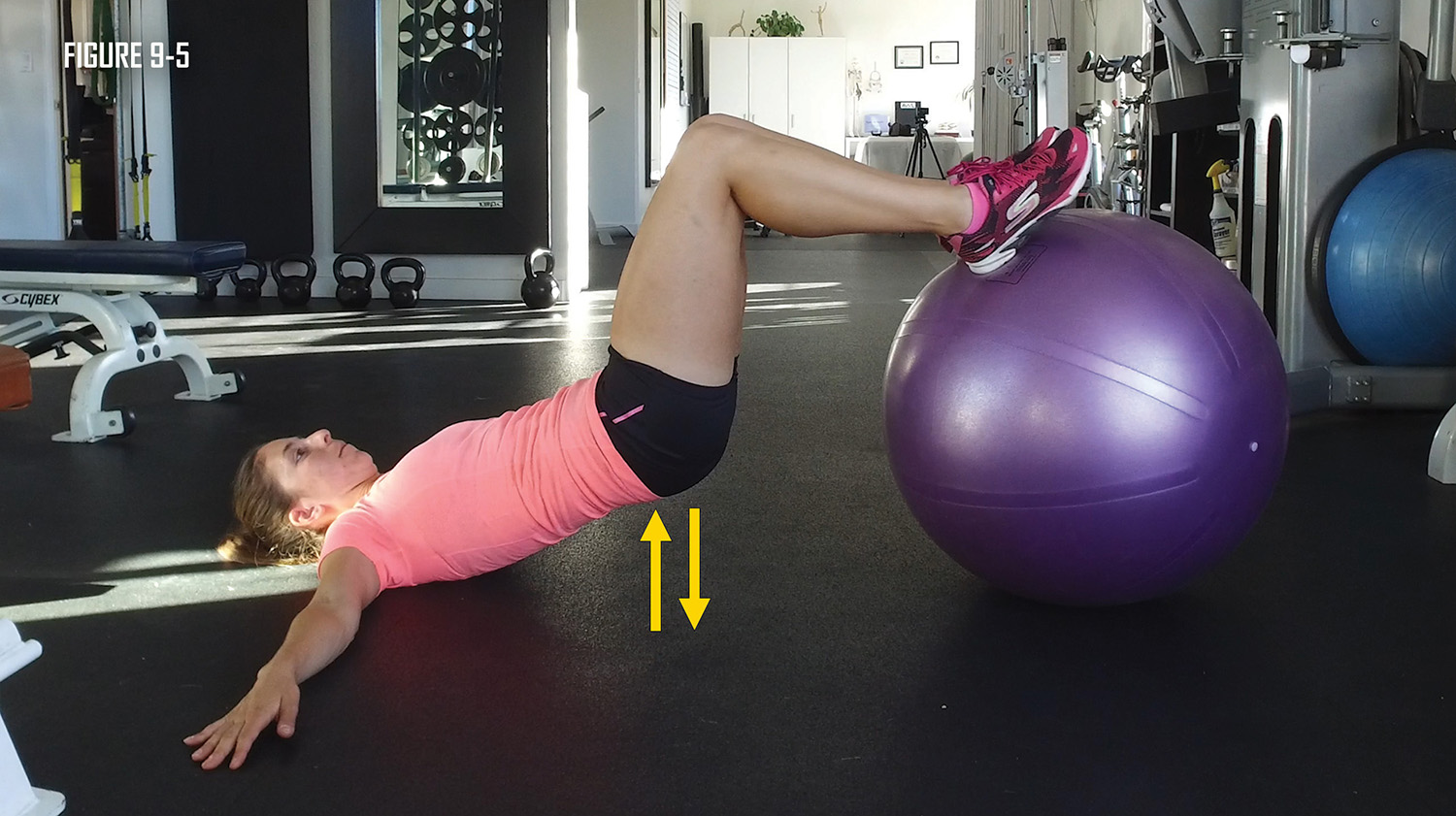
Stand up straight! How many times have you heard that? It sounds easy, but it isn’t always easy to accomplish. In ideal race walking posture, the torso is in the vertical position (Figure 10-2). Some race walkers never achieve this, while others develop problems when they become tired late in races. In general, posture problems fall into two main categories: leaning forward (Figure 10-1) and leaning backward (Figure 10-3).

Good posture (Figure 10-5) also helps more of the stride to be behind the body instead of in front of the body. In contrast, leaning forward (Figure 10-4) or backward (Figure 10-6) restricts hip rotation and limits the stride behind the body. Many race walkers are not aware of the problems with their posture. With the availability of video cameras and high speed still photography, have someone take a video or series of photos of you race walking. Either stop on a frame or grab a still when your supporting leg is beneath your body. Draw a vertical line and compare it to your body position.

If you have an issue, here are some simple steps to help correct it.
Correcting Leaning Forward
Forward lean is very undesirable in race walking. It can be caused for many reasons, including poor coaching. The main physical causes are tight abdominal muscles, overdeveloped or tight pectoral muscles, weak lats (the biggest back muscle group), and/or a weak lower back. While focus alone won’t correct all of your posture issues, it’s a good place to start.

Your posture often follows your head position. If you drop your head (Figure 10-7), your posture is sure to follow, and you will slouch forward. When you race walk, focus on keeping your head up (Figure 10-8). Pay attention to your chin as well. Keeping it up helps to bring your posture upright as well as allowing your airway to stay open, letting your body get maximum oxygen when the going gets tough.


One challenge to correcting posture is that your posture issues may not be related to race walking. Your posture may be incorrect in your pedestrian style walk as well. If so, then you are correcting decades of bad habits and imbalance. One of the first steps is for you to feel what it feels like to actually walk in the vertical position.
If you have someone who can help you, have them place your body in the vertical position. If you previously leaned forward, you might feel like you are falling backward. Likewise, if you are leaning backwards, you might feel like you are falling forward. If you are alone or want more practice, you could also do this using a treadmill and mirror. Make a vertical line on the mirror to show where your body should be when you are walking on the treadmill. Focus on walking (positioning the mirror to the side of the treadmill) while keeping your body even with the line.
Next, we need to strengthen and improve the flexibility of the muscles causing you to lean forward. Do the following exercise three times per week.

This Alternate Arm and Leg exercise doesn’t require a gym or even weights. It strengthens the lower back muscles as well as the glutes, hamstrings, and to some degree the shoulders and thus helps to correct forward lean.
Body Position
Lying on your stomach, hold your arms and legs straight out.
Steps
- While exhaling, raise one arm and the opposite leg from the floor; Be sure to keep them mostly straight and inhale as you lower your limbs (Figure 10-9).
- Exhale while raising the opposite arm and leg, keeping them mostly straight (Figure 10-10). Inhale as you lower them.
- Repeat, 2 sets of 10.


This exercise is a variation of the Alternate Arm and Leg exercise that also strengthens the lower back muscles as well as the glutes, hamstrings, and to some degree the shoulders.
Body Position
Lying on your stomach, hold your arms and legs straight out (Figure 10-11).
Steps
- Simultaneously, exhale and raise your arms and legs off the floor (Figure 10-12); Be sure to keep them straight.
- Hold for 3 seconds.
- Inhale as you lower your arms and legs.
- Repeat 15 times.


This exercise helps to correct leaning forward because if your lats aren’t strong enough, your torso will be pulled forward by your abdominal muscles. This is especially true for people who have done a lot of abdominal work while neglecting their back.
Body Position
Sit in front of a lat machine.
Steps
- Grab the bar with your palms facing away from you, and place your hands at end of the bar.
- While exhaling, pull the bar down in front of your body.
- Lower the bar all the way down to past your chest (Figure 10-13).
- Slowly, return the bar back to the top, stopping just before your arms completely straighten (Figure 10-14).
- Keep control while raising and lowering the weight.
- Don’t let the bar swing back excessively as you return to a starting position.
- Perform 10 repetitions for 3 sets.


If you already have strong pectoral muscles, the muscles located in your chest, a rowing machine balances by strengthening your rhomboids, which are located in your upper outer back, between your shoulder blades and your spine. Strengthening your rhomboids pulls you upright so that you don’t lean forward.
Body Position
Sit on the seat of a rowing machine.
Steps
- Grab the handles of the machine with straightened arms (Figure 10-15).
- Pull back on the cable(s), keeping your back straight (Figure 10-16).
- Inhale while you lower the weight by straightening your arms.
- Repeat 20 times for 3 sets.


For those with a healthy back, a back extension machine strengthens the lower back to hold you in a good upright posture and helps to correct leaning forward.
Steps
Since there are many different types of back extension machines, follow the instructions at your local gym. Please do not try this exercise if you have back problems.


The Bridge with Ball exercise introduced early is a great way to strengthen and pull you posture backward into a vertical position.
The Bridge with Ball exercise strengthens the lower back muscles and hamstrings. This is a complementary exercise that helps but is not specific to one hip rotation problem.
Body Position
Lie on your back.
Steps
- Place your feet on an exercise ball.
- Place your hands at your side.
- While exhaling, raise your butt from the floor and hold for 2 to 3 seconds (Figure 9-5).
- While inhaling, lower your butt back to the floor.
- Repeat up to 20 times; do 2 sets.


Tight pectoral muscles pull your shoulders into a forward, rounded position, thus causing you to lean forward as you race walk. The Pec stretch loosens them.
Body Position
Stand in a doorway.
Steps
- Place one arm against the doorway, holding your arm at an 80-degree angle with the side of your body.
- Lean forward, maintaining a vertical body alignment, until you feel the stretch across your pecs (Figure 10-19).
- Hold for 30 seconds.
- If you don’t feel the stretch, bend your arm at your elbow at a 90-degree angle.
- Repeat five times on each side.


This stretch corrects leaning forward if your abdominals are tight. It stretches them into extension.
Body Position
Lie face down, extending your legs behind you with your feet together.
Steps
- Place your hands on the side of your body, even with your shoulders (Figure 10-20).
- Keeping your legs on the floor and feet flat, push your body up while exhaling (Figure 10-21).
- Hold for five seconds.
- Lower your body down while inhaling.
- Repeat ten times.


The Standing Back stretch corrects the problem of leaning forward due to tight abdominal and back muscles. It does so by stretching them into extension.
Body Position
Stand with your feet shoulder width apart.
Steps
- Place your hands behind your back (Figure 10-22).
- Lean backwards (Figure 10-23).
- Hold for two seconds.
- Return to the upright posture.
- Repeat ten times.

Correcting Leaning Backwards
People lean backward for many reasons. The major culprits are weak abdominal muscles and a tight lower back. Both of these conditions lead to inefficient race walking style, but more importantly they can lead to injuries and lower back pain.
While it may take a while to correct this problem, it is time well spent, because the benefits from the following exercises will not only help your race walking, but also help you walk better in your daily life.

This exercise strengthens the abdominals and shoulders, helping to prevent leaning backwards.
Body Position
Hold an exercise ball in front of your body and below your waist (Figure 10-24).
Steps
- Exhale while you raise the ball to the height of your forehead, making sure to keep your back straight (Figure 10-25); Tighten your abdominals as you raise the ball.
- Continue to exhale as you hold the ball in place for 2-3 seconds.
- Inhale while you slowly lower the ball to your waist.
- Repeat 15 to 20 times.


Use the Traditional Stomach Crunches as a very basic method of strengthening your abdominal muscles without overly stressing your back to help prevent a backward lean.
Body Position
Start by lying down on a firm surface. Bend your knees and bring both feet toward your buttocks, so that your legs form a triangle with the ground (Figure 10-26).
Steps
- Place your hands across your chest and exhale while curling upward with your chin tucked against your chest; Roll your upper body off the ground (as much as eight inches), pressing your lower back to the ground as you curl (Figure 10-27).
- Hold for three seconds.
- Inhale while reversing your movements and lowering your body to its original position.
- Repeat the exercise as many times as possible (up to a maximum of 100 crunches), but only as long as you can maintain good technique.


The Bicycle Exercise adds a twisting motion to the Traditional Stomach Crunch to increase greater range of abdominal muscles
Body Position
Lay down on a firm surface.
Steps
- Touch your left elbow to your right knee, lifting your torso up as you do (Figure 10-28).
- Simultaneously lower your raised elbow and knee while raising the opposite knee and elbow (Figure 10-29).
- Repeat the exercise 25 times.


The Upper Back stretch allows you to get more comfortable posture and remove your backward lean by stretching your upper back.
Body Position
Wrap your hands around a pole, standing far enough back that your arms are straight. Place your feet comfortably so you maintain balance.
Steps
- Lean backward, feeling the stretch through your upper back (Figure 10-30).
- Hold for ten seconds.
- Return to a standing position.
- Repeat three times.


This is a comfortable way to stretch the lower back and remediate a backward leaning posture.
Body Position
Lie down on your back and place your hands just before the hamstring/ knee insertion point (Figure 10-31).
Steps
- Pull your knees towards your chest and hold for 30 seconds (Figure 10-32) and repeat 5 times.


A simple, comfortable way to stretch the lower back and help remediate a backward lean in your posture.
Body Position
Kneel on the floor, with your knees hip width apart.
Steps
- Use your hands for support.
- Lower your head.
- Slide back to a seated position with your buttocks on your heels.
- Stretch forward, reaching out with your hands (Figure 10-33).
- Hold for 30 seconds.
- You can alternate by rotating your hands to each side.
- Repeat five times.
